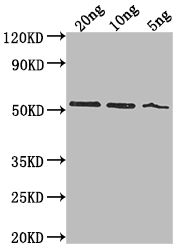The lasB polyclonal antibody is developed by immunizing a rabbit with the recombinant Pseudomonas aeruginosa lasB protein (198-498aa). Following this, the lasB antibody is extracted from the rabbit serum and subjected to purification using protein G. This specific lasB antibody is designed to detect the lasB protein of Pseudomonas aeruginosa and is highly suitable for use in ELISA and WB applications.
The main function of the Pseudomonas aeruginosa lasB protein, also known as elastase, is to degrade elastin, a major component of connective tissues. Elastase helps the bacterium invade host tissues by breaking down elastin and other extracellular matrix components. Additionally, elastase can also degrade other proteins, such as immunoglobulins, complement components, and cytokines, which can impair the host immune response.





